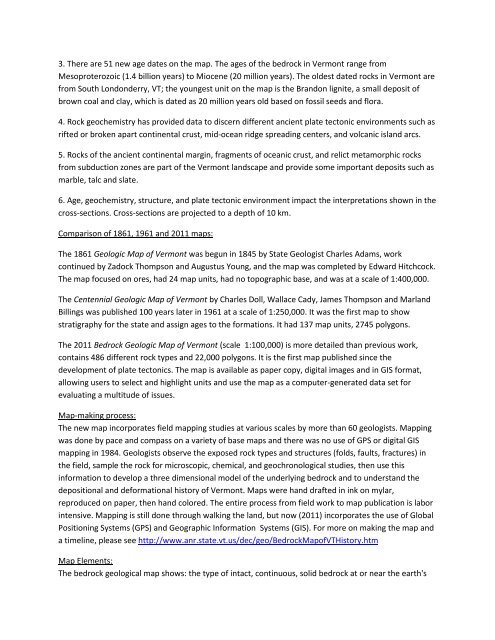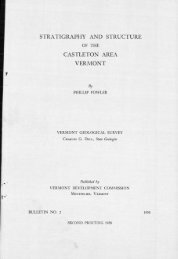The Inside Story - Vermont Agency of Natural Resources
The Inside Story - Vermont Agency of Natural Resources
The Inside Story - Vermont Agency of Natural Resources
You also want an ePaper? Increase the reach of your titles
YUMPU automatically turns print PDFs into web optimized ePapers that Google loves.
3. <strong>The</strong>re are 51 new age dates on the map. <strong>The</strong> ages <strong>of</strong> the bedrock in <strong>Vermont</strong> range from<br />
Mesoproterozoic (1.4 billion years) to Miocene (20 million years). <strong>The</strong> oldest dated rocks in <strong>Vermont</strong> are<br />
from South Londonderry, VT; the youngest unit on the map is the Brandon lignite, a small deposit <strong>of</strong><br />
brown coal and clay, which is dated as 20 million years old based on fossil seeds and flora.<br />
4. Rock geochemistry has provided data to discern different ancient plate tectonic environments such as<br />
rifted or broken apart continental crust, mid-ocean ridge spreading centers, and volcanic island arcs.<br />
5. Rocks <strong>of</strong> the ancient continental margin, fragments <strong>of</strong> oceanic crust, and relict metamorphic rocks<br />
from subduction zones are part <strong>of</strong> the <strong>Vermont</strong> landscape and provide some important deposits such as<br />
marble, talc and slate.<br />
6. Age, geochemistry, structure, and plate tectonic environment impact the interpretations shown in the<br />
cross-sections. Cross-sections are projected to a depth <strong>of</strong> 10 km.<br />
Comparison <strong>of</strong> 1861, 1961 and 2011 maps:<br />
<strong>The</strong> 1861 Geologic Map <strong>of</strong> <strong>Vermont</strong> was begun in 1845 by State Geologist Charles Adams, work<br />
continued by Zadock Thompson and Augustus Young, and the map was completed by Edward Hitchcock.<br />
<strong>The</strong> map focused on ores, had 24 map units, had no topographic base, and was at a scale <strong>of</strong> 1:400,000.<br />
<strong>The</strong> Centennial Geologic Map <strong>of</strong> <strong>Vermont</strong> by Charles Doll, Wallace Cady, James Thompson and Marland<br />
Billings was published 100 years later in 1961 at a scale <strong>of</strong> 1:250,000. It was the first map to show<br />
stratigraphy for the state and assign ages to the formations. It had 137 map units, 2745 polygons.<br />
<strong>The</strong> 2011 Bedrock Geologic Map <strong>of</strong> <strong>Vermont</strong> (scale 1:100,000) is more detailed than previous work,<br />
contains 486 different rock types and 22,000 polygons. It is the first map published since the<br />
development <strong>of</strong> plate tectonics. <strong>The</strong> map is available as paper copy, digital images and in GIS format,<br />
allowing users to select and highlight units and use the map as a computer-generated data set for<br />
evaluating a multitude <strong>of</strong> issues.<br />
Map-making process:<br />
<strong>The</strong> new map incorporates field mapping studies at various scales by more than 60 geologists. Mapping<br />
was done by pace and compass on a variety <strong>of</strong> base maps and there was no use <strong>of</strong> GPS or digital GIS<br />
mapping in 1984. Geologists observe the exposed rock types and structures (folds, faults, fractures) in<br />
the field, sample the rock for microscopic, chemical, and geochronological studies, then use this<br />
information to develop a three dimensional model <strong>of</strong> the underlying bedrock and to understand the<br />
depositional and deformational history <strong>of</strong> <strong>Vermont</strong>. Maps were hand drafted in ink on mylar,<br />
reproduced on paper, then hand colored. <strong>The</strong> entire process from field work to map publication is labor<br />
intensive. Mapping is still done through walking the land, but now (2011) incorporates the use <strong>of</strong> Global<br />
Positioning Systems (GPS) and Geographic Information Systems (GIS). For more on making the map and<br />
a timeline, please see http://www.anr.state.vt.us/dec/geo/BedrockMap<strong>of</strong>VTHistory.htm<br />
Map Elements:<br />
<strong>The</strong> bedrock geological map shows: the type <strong>of</strong> intact, continuous, solid bedrock at or near the earth's













